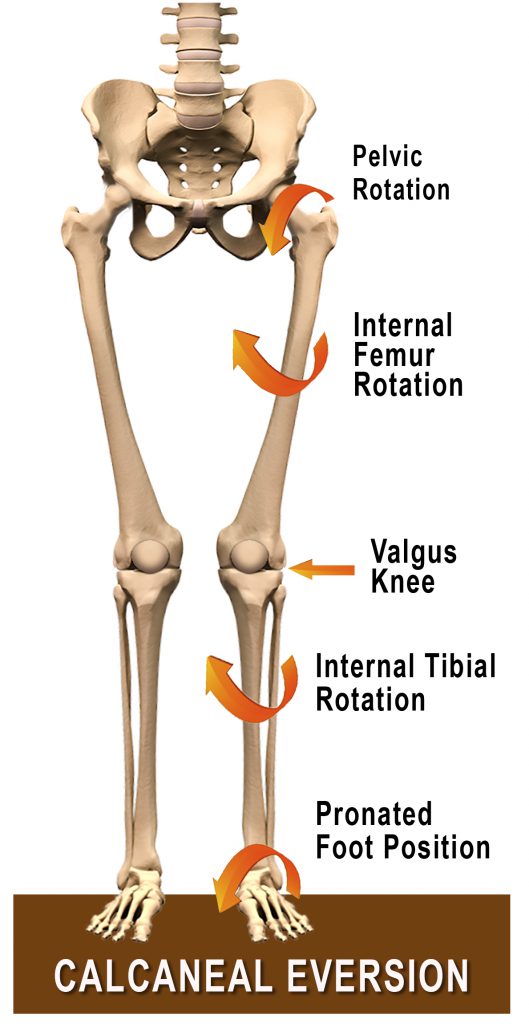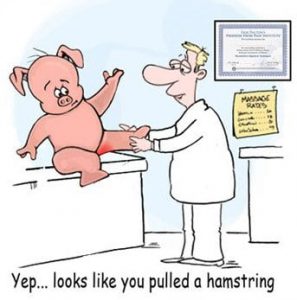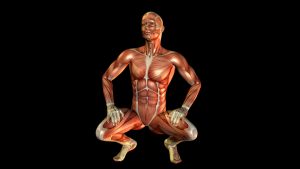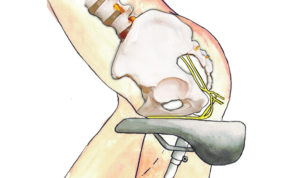The foot and ankle have two important jobs: mobility (pronation) and stability (supination). Adequate mobility provides shock absorption, which allows the body to adapt to uneven ground surfaces, and stability provides efficient propulsion. During walking, the knee flexes, abducts (valgus), and internally rotates. The hip responds to the calcaneal eversion and foot pronation by flexing, adducting, and internally rotating (Fig.1). Since the pelvis is driven by a combination of gravity and ground reaction force (GRF), rotational motion will also be created in the lumbar spine.

It is often said that these gravitationally induced motions are “given for free,” meaning there is very little energy expenditure. Yet, to counteract the structural collapse and propel the body forward, muscles must decelerate the compressive forces (eccentric contraction), and then spring the system in the opposite direction. When the foot and ankle are functioning properly, the body’s proprioceptive system turns on hip and core muscles, but frequently, that’s not the case.
The goal of functional assessments is to determine if the client has too much or too little calcaneal eversion and whether they are properly using this motion during gait. Although it’s important to assess and correct the commonly seen hyperpronated foot, it’s equally important to recognize how the lack of calcaneal eversion can destroy the body’s anti-gravity spring system and retard core muscle activation. If excessive calcaneal eversion is too much of a good thing, then limited eversion isn’t enough of a good thing!
In the following Myoskeletal assessment, treatment and corrective exercise article, Paul Kelly and I work with an MMT fighter with excessive calcaneal eversion. In touch, Erik
Assessing calcaneal eversion or inversion
ACTION:
• Therapist places marks on client’s Achilles tendon to determine if the ankle or foot is pronating or supinating
• Therapist assesses if the squinting patella is more prominent on the pronated foot causing the knee joint to assume a valgus (knock kneed) position
Calcaneal eversion technique for hyperpronated feet
ACTION:
• Therapist grasps client’s foot and abducts client’s extended leg off the table
• Therapist’s right webbed hand grasps below the medial and lateral malleoli and his left drapes over his right
• Therapist places client’s foot and ankle between his slightly flexed knees
• Therapist drops his body weight back to decompress the ankle
• Therapist twists his hips to mobilize the ankle and foot bones
• To restore calcaneal alignment for those with a hyperpronated foot, therapist brings the foot into supination, asks client to pronate against his resistance to a count of 5 and relax, and therapist supinates the arch by inverting the ankle
• To restore mobility to the bones of the arch, therapist’s fingers push the arch up as the therapist drops his weight back causing plantar flexion of client’s foot
Home retraining for foot, ankle and leg strength
ACTION: One-legged leg balancing to mobilize ankle and strengthen arch, ankle, and leg muscles
• Standing client places his right foot on a “wobble” platform and flexes his left knee to 90 degrees to increase strength and improve whole-body proprioception
• Client attempts to hold for 30 seconds to a minute (2 to 3 sets) and repeats on both feet daily
On sale this week only!
Save 25% off the "Dalton Technique Treasures" eCourse
The “Dalton Technique Treasures” eLearning course is a compilation of some of Erik’s favorite Myoskeletal Alignment Techniques (MAT). Learn MAT techniques to assess and address specific sports injuries, structural misalignment, nervous system overload, and overuse conditions. ON SALE UNTIL July 29th! Get Lifetime Access: As in all our eLearning courses, you get easy access to the course online and there is no expiry date.







